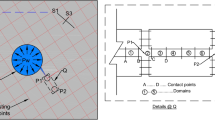Abstract
The Neelum–Jhelum Hydropower Project, commissioned in April 2018 and located in the Azad Kashmir region of northeast Pakistan, is one of the most challenging and technically complex projects in the region. The project’s 28.6 km headrace tunnels are constructed in a highly mountainous region with relatively complex geology that includes various sedimentary rocks of Murree formation. The hydro-mechanical behavior of the deep headrace tunnels with a maximum overburden of 2000 m and underground powerhouse at a depth of 450 m are of particular interest. The project generates electricity by diverting water from the Neelum River to an underground powerhouse through a tunnel system crossing beneath the Jhelum River. The pressurization of the hydraulic tunnels was an important milestone and necessitated intentional planning down to the smallest detail for the first filling. Successful filling was a governing criterion for proper functioning of the tunnel lining that was supplemented by monitoring instruments, a drainage system, and ground treatments during construction of the project. Ground re-saturation during the first filling of the concrete and shotcrete-lined waterways constructed in the diversified rock mass is interesting to study. The rock mass in this area is sheared and fractured, with open fissures. In this study, we investigated the ground re-saturation and water leakages in adits, plugs, and surface outflow after the first filling of the headrace tunnel. A load rejection test was conducted to evaluate overall fitness of the power waterways, plant, and to study any change in leakages due to sudden oscillation in the waterway tunnels. Surfer3D software was used to analyze the data collected from the piezometers, which showed abnormal water pressure built up in a localized zone between penstocks three and four. This study was also supported with two-dimensional finite element modeling of the project, at a location where the tunnel has minimum rock cover susceptible to hydrojacking. Numerical analysis results were compared with field data results during the first filling process and both showed close proximity.



















Similar content being viewed by others
References
Abbasi AH (2014) Pakistan energy vision, 2035, SDPI
Esteves C, Plasencia N, Pinto P, Marques T (2017) First filling of hydraulic tunnels of Venda Nova III hydropower scheme. In: Proceedings of the World Tunnel Congress. Bergen, Norway
Fernández G (1994) Behavior of pressure tunnels and guidelines for liner design. J Geotech Eng 120:1768–1791
Golden Software (2010) Surfer 3D. Golden, Colorado: Golden Software, LLC
Holmøy KH (2008) Significance of geologicalparameters for predicting waterleakage in hard rock tunnels
Lamas LN, Leitão NS, Esteves C, Plasencia N (2014) First infilling of the Venda Nova II unlined high-pressure tunnel: observed behaviour and numerical modelling. Rock Mech Rock Eng 47:885–904
Lipponen A, Manninen S, Niini H, Rönkä E (2005) Effect of water and geological factors on the long-term stability of fracture zones in the Päijänne Tunnel, Finland: a case study. Int J Rock Mech Min Sci 42:3–12
Marence M (2008) Numerical modelling and design of pressure tunnels. In: Proceedings of the international conference HYDRO, 2008
Merritt AH (1999) Geologic and geotechnical considerations for pressure tunnel design. In: Geo-engineering for underground facilities, 1999, ASCE, pp 66–81
Naji AM, Emad MZ, Rehman H, Yoo H (2019) Geological and geomechanical heterogeneity in deep hydropower tunnels: a rock burst failure case study. Tunn Undergr Space Technol 84:507–521
Panthi KK (2006) Analysis of engineering geological uncertainties related to tunnelling in Himalayan rock mass conditions
Panthi KK, Basnet CB (2019) Leakage potential through a shotcrete lined high-pressure headrace tunnel-An analysis on a case from Nepal. In: Rock mechanics for natural resources and infrastructure development
ROCSCIENCE (1998) Phase2 User's Guide. Toronto, Ontario, Canada (1998): Rocscience Inc.
Rothfuss BD, Bednarz SL, Clarke ES (2010) Water tunnel condition assessment: a comprehensive approach to evaluating reliability. Jacobs Associates
Schleiss A (1986) Design of pervious pressure tunnels. Water Power Dam Constr 38:21–26
Sharp JC, Gonano LP (1982) Rock engineering aspects of the concrete lined pressure tunnels of the Drakensberg pumped storage scheme. In: ISRM International Symposium, 1982. International Society for Rock Mechanics and Rock Engineering
Sinha RS (2012) Underground structures: design and instrumentation. Elsevier, Amsterdam
Wang T, Hu W, Wu H, Zhou W, Su K, Cheng L (2018) Seepage analysis of a diversion tunnel with high pressure in different periods: a case study. Eur J Environ Civ Eng 22:386–404
Acknowledgements
The authors (Abdul Muntaqim Naji and Hafeezur Rehman) are extremely thankful to the Higher Education Commission (HEC) of Pakistan for HRDI-UESTPs scholarship. This work was supported by the National Research Foundation of Korea Grant funded by the Korean Government (NRF-2019R1A2C2003636).
Author information
Authors and Affiliations
Corresponding author
Ethics declarations
Conflict of interest
The authors declare that they have no conflict of interest.
Additional information
Publisher's Note
Springer Nature remains neutral with regard to jurisdictional claims in published maps and institutional affiliations.
Rights and permissions
About this article
Cite this article
Ahmad, S., Naji, A.M., Hussain, I. et al. Ground Saturation Response During First Filling of Lined Pressure Tunnels: A Case Study. Rock Mech Rock Eng 54, 513–535 (2021). https://doi.org/10.1007/s00603-020-02296-9
Received:
Accepted:
Published:
Issue Date:
DOI: https://doi.org/10.1007/s00603-020-02296-9




